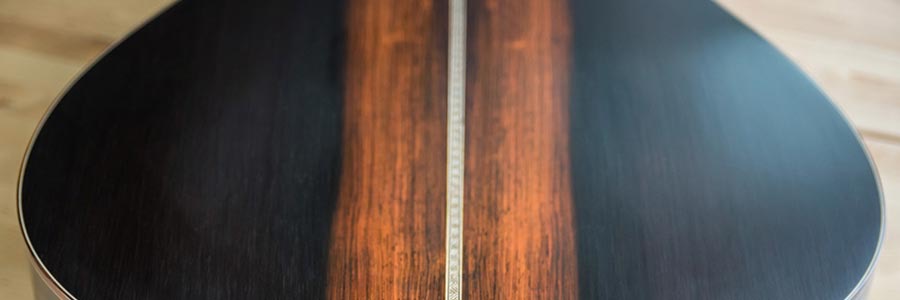
Luthiers put a great deal of thought into the particular woods they use for a guitar’s sides, back, soundboard, neck, and fretboard. Collectively, the woods that are used to make guitars (and other musical instruments) are called tonewoods. Tonewoods are a complex business, but it’s difficult to shop for guitars without understanding the basics. The wood(s) used to make a guitar will have a direct impact on its tone, weight, price, and most other characteristics.
“The only way you can really know what each tonewood sounds like if you to just go ahead and play 100 different guitars with different tonewood set-ups,” says Scott Miller, a luthier here in New Hampshire. “But even still, two pieces of mahogany from different trees would sound different.” He encourages people to be open to a range of tonewoods when they shop for guitars.
Traditionally, the major tonewoods have been ash, mahogany, maple, rosewood, and spruce. These trees were plentiful during the first half of the 20th century, and they shaped our understanding of classic guitar tone. As many of these woods become scarce due to overharvesting and deforestation, guitar makers are turning to alternative tonewoods that sound great and are grown more sustainably.
Tonewoods Are Subjective
The most important thing to remember about tonewoods is that they are subjective. Some exotic tonewoods are valuable because they are rare, or because somebody finds them beautiful — not necessarily because they sound the best.
And what sounds “the best” isn’t exactly objective, either!
The Impact of Tonewoods on Electric Guitar Tone
The impact of the choice of wood(s) on the sound of an acoustic guitar is hard to underestimate. With an electric guitar, though, the pickups and amps significantly affect the overall tone. YouTube is full of people claiming that the entire concept of tonewoods for solid-body electric guitars is meaningless marketing hype. Scott says those people are totally wrong.
“I’ve heard people who call themselves luthiers who build electric guitars say, ‘It doesn’t matter what you use for tonewoods for the neck and the body. As long as you’re using high-quality pickups, it’s going to sound good.’ And that’s not true at all. I can color a guitar by altering the pickups, but if it doesn’t sound good acoustically, it’s not going to sound good plugged in.”
Scott Miller
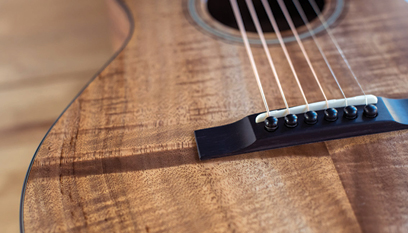
Scott has a great story that illustrates the impact of tonewoods on electric guitars. He once built two guitars for the same customer. The guitars both had the same body shape. One was built to the customer’s aesthetic preferences, and the other was built to his tone preferences. The first guitar was absolutely beautiful. It had a walnut body and neck, an ebony fretboard, and a spalted maple top. The other guitar had a pine body, a Port Orford cedar neck, and a rosewood fingerboard. “If you look at the two guitars, you can see that they’re brother and sister,” Scott says. “One of them is definitely prettier than the other, but when you plug it in, the other one sounds much better.”
He says the customer loves looking at the spalted maple one, but loves playing the pine one.
A Few Handy Woodworking Terms to Know
Before I delve too far into this discussion, let’s review a few useful woodworking terms. You will often see a distinction made between sapwood and heartwood. Sapwood is the living outer portion of a tree. The heartwood is the inner portion of the tree, which is actually dead. Guitars are usually made from heartwood because it is harder, darker, and less vulnerable to insects, but it depends. In many cases, the choice between sapwood and heartwood is just a matter of aesthetics and personal preference. Some high-end acoustics use both, creating a contrasting stripe that looks really cool (to me, anyway!).
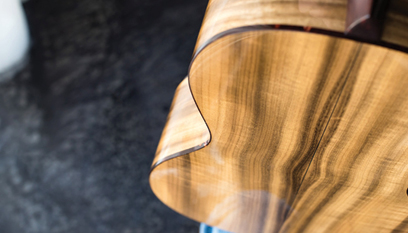
Figure refers the pattern or shape of the side-grain. A piece of wood is considered “figured” when the pattern is particularly dramatic. “Figured” woods are often more expensive because they are unusual. If you’ve ever shopped for granite countertops, you know that stone can also be “figured.” Figured stone might remind you of something interesting, like a bolt of lightning or the surface of Jupiter. You either love it or hate it, but you won’t think it’s boring! When you look up specific woods you might see something called the Janka rating, which is a measure of hardness. The higher the number, the harder the wood is. For example, basswood is a very soft wood, and it has a Janka rating of 410. Cocobolo has a Janka rating of 2960. Does the actual number matter a whole lot? No, but harder woods typically make more durable fretboards, for example. Tonewoods can get confusing because so many woods are known by multiple names, and some of those names aren’t accurate. For example, quite a few of these woods have “rosewood” in their name. Rosewoods are heavy, hard, and dense, making them a very strong and beautiful choice for the sides and backs of acoustic guitars. But not all “rosewoods” meet the scientific definition. A true rosewood is part of the genus Dalbergia of the family Fabaceae — anything else isn’t a real rosewood. Why am I bothering with this technicality? I’ll explain further in a minute, but basically, the true rosewoods have become harder to buy due to international environmental protections. Most of the rosewood-wannabes are not included.
The Holy Grail of Tone: Brazilian Rosewood
Later on in this post, I’ll talk about the environmental restrictions on one particular kind of rosewood: Brazilian. Brazilian rosewood is one of the most prized tonewoods in the world. I’ll let Christine Funk of Thompson Guitars explain it:
“Brazilian rosewood is a tonewood that displays a more complex sound than many woods, and thus is valued by many high-end builders and players. All woods have their own tonal qualities, kind of like the spice in a soup, and Brazilian has a richness in tone that is unmatched by other woods. One factor is that Brazilian has lower overtones than most wood, resulting in a deeper bottom end. To many the complexity and the richness of sound produced by Brazilian guitars is the Holy Grail of tonewoods. That, coupled with certain challenges that the wood can create for the builder and the lower availability of good quality wood, contributes to the price.”
Christine Funk, General Manager of Thompson Guitars
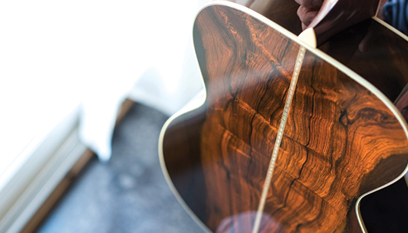
I have put together a list of domestic and exotic tonewoods that you might encounter, although it is certainly not exhaustive:
Practical Downsides of Some Exotic Tonewoods
Have you fallen in love with the vibrant shades of a particular tropical tonewood? I can’t blame you. Many of them are absolutely gorgeous! Just be careful, because the wood may not stay that color. For example, padauk and cocobolo get much darker over time thanks to oxidation. When it’s cut, Bois de Rose is purple — but eventually turns almost black! While certain finishes may help to preserve the original color, there are plenty of other tonewoods that do not change color so dramatically. You could always go with a brightly colored, long-lasting stain instead.
Some of these exotic woods can cause an allergic reaction similar to poison ivy. For example, the sawdust may irritate the skin (causing contact dermatitis) or the eyes. Luthiers and other woodworkers should handle exotic tonewoods carefully, and use a dust mask when sanding. While some people do react to jewelry made from cocobolo, playing a finished, sealed guitar will usually not cause any problems.
Not all visually stunning woods are practical for building guitars. Some types of wood are prone to splitting or warping, or so oily they’re difficult to glue, or don’t accept stain well. And some trees don’t grow large and straight enough to be very useful.
Sustainability and CITES
Some trees are very plentiful, especially when harvested responsibly. If you can make a $300 guitar out of it, it’s in no danger of going extinct anytime soon. But deforestation is a major problem in many of the developing countries where the more exotic tonewoods are found. Many of these prestigious trees grow in the middle of the forest surrounded by other tree species, and they can’t be accessed without clear-cutting a large area. Musical instruments are hardly the biggest driver of deforestation in these countries. Most of these trees are being used in construction, turned into paper, or burned for fuel. But the ever-increasing environmental price tag of these precious tonewoods is certainly affecting guitar manufacturers, as we will see.
Governments around the world have banded together to keep these species (and entire forests and habitats) from getting wiped out. Thanks to those restrictions, some of these woods are no longer legal to export. In some cases, it’s not even legal to own finished products made out of the wood unless you have special permission from the Fish and Wildlife Service, or whatever your local equivalent is. Such guitars must have “papers,” sort of like purebred dogs!
Many of the most well-known restrictions on endangered plants and wildlife come from an international conservation treaty called CITES (Convention on International Trade in Endangered Species of Wild Fauna and Flora). The vast majority of the world’s countries are members of CITES, and they meet periodically to review endangered species. The most recent meeting, known as CoP17, was in South Africa in 2016.
CITES has three lists of protected species, known as Appendices:
- Appendix I: Species that are in danger of extinction. Chimpanzees, tigers, cheetahs, and rhinos are some of the animals included in Appendix I. Elephant ivory, which is found on some vintage guitars, is also included. Items and wild animals on this list cannot be legally imported.
- Appendix II: Species that could become further endangered without trade restrictions. The great white shark and the American black bear are both included in Appendix II. These items can be imported, but permits are required. There are about 30 times more species in Appendix II than Appendix I.
- Appendix III: Species that have been added at the request of a particular country. The associated export restrictions only apply to that country. For example, Spanish cedar is included for several countries in South and Central America.
What does all this mean for tonewoods? Well, Brazilian Rosewood has been listed in Appendix I since the early 1990s. That means that you can’t take Brazilian rosewood — or any finished product made with Brazilian rosewood! — across national borders unless you can prove the wood predates the ban. If you already own a Brazilian rosewood guitar from before the ban took effect, be sure you have the proper paperwork before you try to fly internationally with it. Otherwise, it could be confiscated at the airport and you’ll never see it again.
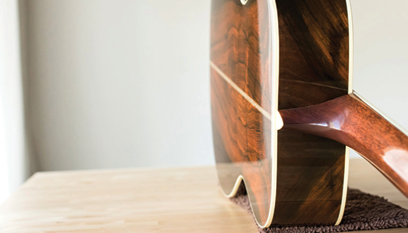
The most recent CITES convention, CoP17, created a big headache for the guitar manufacturing industry when it added the entire genus of Dalbergia (almost 300 rosewood species) and Bubinga to Appendix II. These restrictions, which took effect in January 2017, have made non-Brazilian rosewood more expensive due to all the red tape involved.
Why did CITES make such a sweeping change? The soaring demand for rosewood in China.
Rising affluence in China has meant that more people can afford high-end furniture made of rosewood, called Hongmu. This has led to rapid deforestation and even violent crime (the “blood wood” wars) in the developing countries where these trees grow. Sadly, illegal poaching still continues.
It’s important to remember that CITES is not the only law that affects endangered tonewoods. Member countries are free to adopt more stringent import and export rules. In the US, various federal laws also apply, including the Endangered Species Act and the Lacey Act. You may remember hearing about Gibson Guitars paying hundreds of thousands of dollars in 2012 to settle a dispute over imported African tonewoods. That case was brought under the Lacey Act, which was amended in 2008 to include plants.
Another key point about CITES is that it protects the plant in its native environment. Honduras mahogany has some protection under Appendix II, but hardly any old-growth mahogany is still commercially harvested from Central and South America (most of it is gone). Most of the mahogany available today actually comes from plantations in Southeast Asia. The CITES protections do not apply, because the plant is not native to that region.
How to Choose a More Environmentally Responsible Guitar
So what can you do to ensure that your next guitar purchase isn’t contributing to an ecological nightmare?
- Choose a traditional tonewood that was harvested responsibly. Look for the logo of the Forest Stewardship Council, which indicates that the wood was sourced from sustainable, well-managed forests.Research guitar makers and choose one that is committed to sustainable practices. Bedell, for example, has taken great steps to ensure they use only ethically-sourced tonewoods.You can even buy guitars made from vintage old-growth wood that was discovered and salvaged.
- Choose an alternative tonewood. Go for a guitar made out of a different, more sustainable wood — or something that isn’t wood at all!
- Buy a used guitar. One of the greenest ways to acquire a guitar is to buy it secondhand.
The Value of Old Growth
When an old tree from a virgin forest is cut down, it can’t be replaced — at least not in our lifetimes. New trees take decades to establish themselves, assuming that people leave the trees alone for long enough (which is not at all guaranteed).
Why does it matter? Wood from old growth trees is denser, harder, and stronger than newer wood. Say you wanted to build a reproduction of an antique barn. You could build the barn using historic plans and methods, but there’s a huge difference between the wood you can buy today and the wood used in the barns of the 1800s. You might not be able to find beams that are thick enough and long enough — and even if you did, they wouldn’t be as strong as the originals were. That’s why there’s a big market for old-growth, such as antique heart pine, that has been salvaged from old buildings.
Luthiers can use salvaged antique wood for guitars, too. In many cases, that’s the only way to make a new guitar using old growth.
Believe it or not, Thompson Guitars uses Brazilian rosewood for new guitars — totally legally! The wood they use was cut down in the 1930s, so it pre-dates CITES by a wide margin. It was discovered in a shipwreck at the bottom of the ocean. Preston Thompson also offers guitars made with 19th century mahogany (known as sinker mahogany) that was pulled from rivers in Belize.
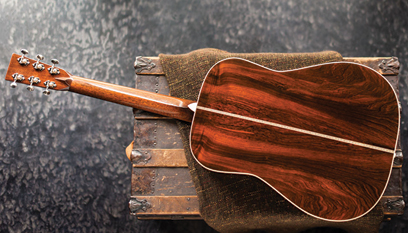
Here in New Hampshire, a famous old brewery building from the 1880s was being turned into apartments, and local luthier Scott Miller was able to pick through the remaining materials. The boards he chose are all old-growth pine, and were probably local to the area. “I’m really excited about building guitars out of that,” he says. “I like the tone, it’s going to look awesome, and it’s going to have this really cool historical value to it.” As you can imagine, supplies of salvaged antique woods are extremely limited, making them an intriguing option for high-end, custom instruments.
Alternative Tonewoods
In response to CITES, many guitar manufacturers replaced the true rosewoods they had been using with more readily available woods. For example, Fender began making the fretboards on its Mexican-made models out of pau ferro instead of rosewood. Fender’s American Elite models now have ebony fretboards. Guitar manufacturers are looking ahead. They want to be able to build beautiful guitars for decades to come, and forests full of traditional woods are disappearing at an alarming rate. The next CITES conference is in 2019, and there’s no reason to expect that fewer species will be endangered.
So for many luthiers, alternative tonewoods are the way forward (“alternative” here meaning something besides the usual rosewood, maple, and mahogany). Some of these are still exotic, but fairly easy to buy because they’re not under threat of extinction. Others are ordinary woods, like oak and pine, that had been mostly overlooked as tonewoods.
Non-Wood Alternatives
For a truly alternative tonewood, consider tonewoods that aren’t even wood!
In case you think I’m crazy, I’ll give you some examples. Gibson makes guitars that feature fretboards made out of Richlite, an ebony alternative that is made out of recycled paper and resin. RainSong makes acoustics out of carbon fiber, and Blackbird Guitar uses a linen/ carbon fiber composite they call Ekoa.
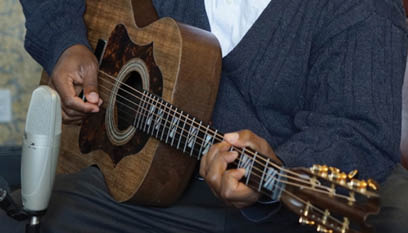
In researching for this post, I found many examples of totally non-traditional guitar designs that are no longer available. This highlights an important point: Guitar manufacturers can dream up whatever they want, but the public doesn’t have to buy it. The market has been trained to expect rosewood and mahogany in their fine instruments, which can make any sort of substitute a hard sell.
An Early Pioneer of Alternative Tonewoods: Danelectro
I wanted to mention Nathan Daniel of Danelectro here, because he was truly a man ahead of his time. Danelectro was a pioneer of alternative tonewoods way back in the 1950s. His semi-solid guitars used a Brazilian rosewood fretboard and a poplar frame… but then things got interesting.
The rest of the body was made of masonite (the same stuff your garage pegboard is made of!) and topped with vinyl. Daniel’s innovative pickups were housed in chrome-plated lipstick tubes. Sears sold these guitars under the name Silvertone for less than a third of the cost of a Strat at the time. You can find reissues on the market today, and the vintage 1950s models are major collectors’ items.

Buy Used
Lastly, consider not buying a new guitar at all. The secondhand market is filled with great guitars looking for a new home! Check out How to Score a Great Guitar at a Yard Sale for some bargain-hunting tips.

